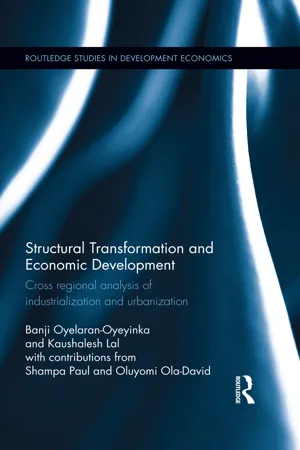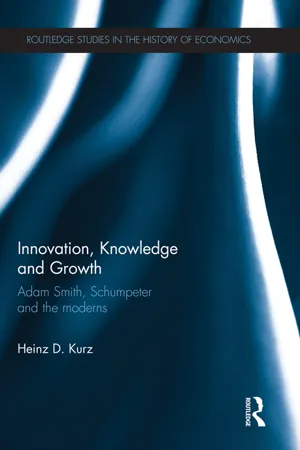Economics
Growth in Productivity
Growth in productivity refers to the increase in the efficiency of producing goods and services. It is often measured by the amount of output produced per unit of input, such as labor or capital. Higher productivity leads to economic growth as it allows for more output to be produced with the same amount of resources, leading to increased standards of living and higher incomes.
Written by Perlego with AI-assistance
Related key terms
Related key terms
1 of 4
Related key terms
1 of 3
12 Key excerpts on "Growth in Productivity"
- No longer available |Learn more
Contemporary Economics
An Applications Approach
- Robert Carbaugh(Author)
- 2016(Publication Date)
- Routledge(Publisher)
33 The most popular measure of productivity for the U.S. economy is average labor productivity. Labor productivity is measured in terms of average output per hour. It is a ratio of the quantity of output to the hours of work done. The quantity of output is based on real GDP, as discussed in this chapter.Rearranging the terms can help illustrate the significance of productivity for economic growth as follows:Total output = Productivity × Hours workedThis shows that total output depends on both work and productivity. Any increase in total output must come from an increase in either hours worked or productivity.As seen in Table 10.4 , U.S. productivity growth has been erratic. During the 1960s, productivity grew by 3.2 percent per year. But during the next three decades, productivity growth fell to less than 2 percent per year only to improve at the turn of the century, and then weaken. Higher rates of productivity growth permit rising real compensation for labor, as this table illustrates.What factors contribute to changes in productivity? Clearly, technological advancement has much to do with productivity gains. During the past century, the development of power-driven machines such as tractors, improvements in transportation such as railroads and airlines, and the growing stock of computers have increased the productivity of workers.Obviously, technological advancement requires invention—that is, the discovery of a new process or product. Yet it also encompasses innovation, the successful introduction and adoption of a new process or product. Henry Ford did not invent the automobile; instead, he was an innovator who pioneered assembly-line production techniques that allowed workers to produce more automobiles in the space of an hour, resulting in falling costs for each automobile produced. - eBook - ePub
The Economy in the 1980s
A Program for Growth Stability
- Michael J. Boskin(Author)
- 2019(Publication Date)
- Routledge(Publisher)
II Productivity and Economic GrowthPassage contains an image 2 MICHAEL J. BOSKIN Economic Growth and Productivity
Measures of economic growth. Changes in economies here and elsewhere. U.S. saving and investment, inflation and taxes. The slowdown in productivity. Structural reforms and reduced tax rates.The mere mention of the term “economic growth” conjures up different images, hopes, and complaints to different people. To the mass of mankind struggling at the margin of subsistence in the world’s less-developed economies, the prospect of economic growth is literally the most important issue facing those individuals and societies. For most persons living in advanced, predominantly free-enterprise, economies such as those of North America and Western Europe, substantial economic progress over the last two centuries has lifted the bulk of the population well above subsistence so that they have come to experience—indeed, to expect—relatively steady increases in their standard of living. Economic growth implies to some people a variety of untoward consequences that occasionally accompany growth, such as environmental pollution and congestion. Hence, we see at the same time movements to halt growth and desperate attempts to increase it; conflicting concerns for growth, appreciation of the need for it, and alternative measures to achieve it pervade what has now become a heated debate. While most would concede that some economic growth is desirable for the less-developed economies of the world, debates rage in most advanced economies over the desirability of growth per se, and especially of the form that growth takes.The most traditional measure of economic growth is the rate of increase of gross national product (GNP) per capita, per employed worker, or per worker hour. For an entire economy this measure obviously is only an average and conceals variations in the growth rate across industries, regions, and population subgroups. Further, since the growth rate reflects the increase in output over and above its original level, rapid increases in growth rates are statistically more likely when the base from which the growth is measured is quite small. But GNP is not by any stretch of the imagination a perfect measure of economic well-being. For example, it fails to include an evaluation of work performed in the household without explicit pay such as caring for and raising children, of changes in the value of leisure time consumed, and of a variety of illegal or off-the-books activities. It also fails to net out the costs embodied in such phenomena as environmental pollution and congestion. Indeed, the oft-quoted example of valuing the output of a factory which belches smoke into the air, and then adding to that output the value of the resources used to clean up the air so dirtied, indicates how misleading traditional income measures can be. - eBook - ePub
- OECD(Author)
- 2016(Publication Date)
- OECD(Publisher)
Labour productivity is the most frequently computed productivity indicator. It represents the volume of output produced per unit of labour input. The ratio between output and labour input depends to a large degree on the presence of other inputs, such as physical capital, intangible fixed assets used in production and technical and organisational change. Labour productivity is a key dimension of economic performance and an essential driver of changes in living standards.Key facts
In countries with relatively low labour productivity levels, stronger labour productivity growth over the last two decades has helped reduce the productivity gap. This is particularly true for some Eastern European countries, the Baltic States and Korea, although their labour productivity levels in 2014 still remained below the OECD average. And while productivity growth rebounded from the crisis lows, growth rates remained far below pre-crisis levels. Labour productivity growth remained relatively weak in the United States and in some large EU economies – Italy and the United Kingdom – compared with the OECD average and a significant productivity slowdown was observed in the Russian Federation and South Africa, mainly reflecting slackening GDP growth.Definition
Labour productivity is defined as GDP per hour worked. GDP is measured as gross value added in market prices. For international comparisons of labour productivity levels, the series of GDP in national currency and at current prices are converted to a common currency, US dollars, using current Purchasing Power Parities (PPPs). Growth rates of labour productivity, instead, are based on measures of GDP in national currency and at constant prices.In productivity analysis, and ignoring quality differences for the moment, labour input is most appropriately measured as the total number of hours actually worked, this is, effectively used in production, whether paid or not (System of National Accounts 2008, 2008 SNA, 19.47). Hours actually worked reflect regular hours worked by full-time and part-time workers, paid and unpaid overtime, hours worked in additional jobs, excluding time not worked because of public holidays, annual paid leaves, strikes and labour disputes, bad weather, economic conditions and other reasons (annex B - eBook - ePub
- Anthony J. Makin(Author)
- 2016(Publication Date)
- Routledge(Publisher)
Lest the figures chosen for this example seem a little removed from reality, it is worth noting that many Asian countries, notably China, India, Indonesia, Malaysia, Singapore, South Korea and Thailand have recorded growth rates of the order of 7 per cent or more in recent decades. In contrast, average growth rate in OECD economies has been below 3 per cent. The arithmetic of compounding dictates that living standards in OECD economies, measured in terms of income per capita, could eventually fall below those of many Asian economies on present trends.The macroeconomic production functionTo understand what drives economic growth, it is necessary to examine factors that contribute to changes in output over time. The starting point is the basic macroeconomic production function that relates the main inputs to production (technology, capital and labour) to output generation on the aggregate supply side of the economy.The most general macroeconomic production function iswhere T represents technology or multifactor productivity, K is the capital stock (defined to include land and buildings) and L is the labour force, usually measured in terms of number of workers, or hours worked. This function suggests that given quantities of physical factor inputs, capital and labour, as well as improvements in technology combine to produce a given level of aggregate output.Macroeconomic growth accountingSo-called growth accounting conveys the contribution that technical change, capital and labour make to changes in output over time. If the macroeconomic production function is characterised by constant returns to scale, then multiplying all factor inputs to aggregate production by some percentage multiplies national output to the same extent. For instance, increasing all inputs by 10 per cent raises aggregate output by 10 per cent.It is possible to express any change in GDP over time aswhere ∆ signifies the period-to-period change in the variable and MPand MPKare the marginal products of capital and labour, respectively. Recall that in competitive equilibrium, MPL, or the addition to output from using an extra unit of capital, is related to the rental cost of capital. Similarly, MPKL - eBook - ePub
- (Author)
- 2021(Publication Date)
- Wiley(Publisher)
The labor supply is determined by population growth, the labor force participation rate, and net immigration. The physical capital stock in a country increases with net investment. The correlation between long-run economic growth and the rate of investment is high.Technological advances are discoveries that make it possible to produce more or higher-quality goods and services with the same resources or inputs. Technology is a major factor determining TFP. TFP is the main factor affecting long-term, sustainable economic growth rates in developed countries and also includes the cumulative effects of scientific advances, applied research and development, improvements in management methods, and ways of organizing production that raise the productive capacity of factories and offices.Total factor productivity, estimated using a growth accounting equation, is the residual component of growth after accounting for the weighted contributions of all explicit factors (e.g., labor and capital).- Labor productivity is defined as output per worker or per hour worked. Growth in labor productivity depends on capital deepening and technological progress.
- The academic growth literature is divided into three theories —the classical view, the neoclassical model, and the new endogenous growth view.
- In the classical model, growth in per capita income is only temporary because an exploding population with limited resources brings per capita income growth to an end.
In the neoclassical model, a sustained increase in investment increases the economy’s growth rate only in the short run. Capital is subject to diminishing marginal returns, so long-run growth depends solely on population growth, progress in TFP, and labor’s share of income. - Robert Whaples, Randall Parker, Robert M. Whaples, Randall E. Parker(Authors)
- 2013(Publication Date)
- Routledge(Publisher)
In evaluating the relative importance of changes in total factor productivity versus factor inputs in accounting for long-run growth, it is critical to recognize that A is measured as a “residual” rather than directly – that is, economists attempt to measure output, factor inputs, and factor shares and then infer the time path of total factor productivity after accounting for changes in factor inputs. This means that any errors in the measurement of the growth rates of output or inputs will likely cause errors in the measurement of the growth rate of total factor productivity.Over time there have been numerous refinements in the quality of both historical and contemporary economic data and thus improvements in the accuracy of growth accounting. However, some problems of measurement are inherent in the process of economic growth itself.In particular, it is easier to measure outputs that are tangible goods – bushels of wheat or steel ingots – than it is to measure outputs that are services. As a share of total output, services produced by the private sectors – for example, the legal profession – have increased over time relative to sectors producing tangible goods (agriculture, manufacturing, and mining). Government, too, is a much larger share of the economy today than a century ago. The output of service industries including government is often measured by the value of inputs rather than independently, which is problematic from a growth accounting perspective.Workers are also healthier and better educated and as a result more productive. Just as new technology is frequently embodied in new capital goods, new knowledge is reflected in rising levels of educational attainment. One view (Griliches and Jorgensen 1967), albeit extreme, is that all increases in Y reflect increases in productive factors, properly measured. Most economists, however, believe that genuine increases in total factor productivity are the key factor behind long-run increases in per capita incomes.The Solow growth model refers to a single (aggregate) economy. In the real world, economies differ in the level of A as well as factor endowments at any point in time. A country with a low value of total factor productivity due to inadequate technology benefits from technology transfer, because it does not have to re-invent the wheel (Gerschenkron 1962). Such transfer may occur privately, if individuals or businesses transport knowledge (and associated capital goods) across borders or it may be encouraged by governments (there are many historical examples) or by international organizations (for example, the World Bank). International factor markets also encourage convergence by transferring resources from low-to high-value uses. For example, if wages are low in one country relative to another – Ireland versus the United States in the 1850s – migration will encourage a narrowing of wage gaps, and this will also lead to convergence in per capita incomes. Under certain conditions, international product markets also encourage convergence through factor price equalization (Samuelson 1948). Williamson (1986) argues that “globalization” – the development and integration of international factor and product markets – has been a major force for income convergence during the past two centuries. Falling costs of international transport and communication, as well as reductions in trade barriers (for example, tariffs) facilitate such globalization and hence convergence.- eBook - ePub
- OECD(Author)
- 2017(Publication Date)
- OECD(Publisher)
Gross Domestic Product (GDP) per capita measures economic activity or income per person and is one of the core indicators of economic performance. Growth in GDP per capita can result from changes in labour productivity (GDP per hour worked) and labour utilisation (hours worked per capita). A slowing or declining rate of labour utilisation combined with high labour productivity growth can be indicative of a greater use of capital and/or of structural shifts to higher-productivity activities.Key findings
Differences in GDP per capita growth across countries can be mainly attributed to differences in labour productivity growth. While labour productivity growth remains a significant driver of growth, it has slowed across the board in recent years, and in Chile, Mexico, Turkey, the United Kingdom and the United States, in particular, increased labour utilisation rates were significant drivers of growth. In many other countries, including some large European economies, growth in labour utilisation rates slowed considerably, and in many, labour utilisation rates fell.Definitions
Growth in GDP per capita is calculated using GDP and population series published in the OECD National Accounts Statistics (database). Labour productivity is measured as GDP per hour worked and labour utilisation as hours worked per capita. Total hours worked are primarily sourced from the OECD National Accounts Statistics (database). For some countries, however, longer time series and/or more recent estimates need to be derived from the OECD Employment and Labour Market Statistics (database), the OECD Economic Outlook: Statistics and Projections (database) and national statistical offices (Chapter 6 ).Information on data for Israel: http://dx.doi.org/10.1787/888932315602 .Comparability
Most countries derive annual estimates of real GDP using annually chain-linked volume indices. However, China, India, Indonesia, Mexico and South Africa currently produce fixed-base volume estimates with the base year updated less periodically. The System of National Accounts 2008 (2008 SNA) recommends the production of estimates on the basis of annual chain volume series. These produce better estimates of growth as the weights used for the contribution of different goods and services are more relevant to the period in question. - eBook - ePub
Structural Transformation and Economic Development
Cross regional analysis of industrialization and urbanization
- Banji Oyelaran-Oyeyinka, Kaushalesh Lal(Authors)
- 2016(Publication Date)
- Routledge(Publisher)
Productivity is considered a key source of economic growth and competitiveness and, as such, is basic statistical information for many international comparisons and country performance assessments. There are different measures of productivity, and the choice between them depends either on the purpose of the productivity measurement and/or data availability. One of the most widely used measures of productivity is gross domestic product (GDP) per hour worked (OECD 2008: 11).Another productivity measure is the multi-factor productivity (MFP) also known as total factor productivity (TFP). It measures the residual growth that cannot be explained by the rate of change in the services of labour, capital and intermediate outputs, and is often interpreted as the contribution to economic growth made by factors such as technical and organizational innovation (OECD 2008: 11).Labour productivity is a revealing indicator of several economic indicators as it offers a dynamic measure of economic growth, competitiveness and living standards within an economy. It is the measure of labour productivity (and all that this measure takes into account) which helps explain the principal economic foundations that are necessary for both economic growth and social development.Although the ratio used to calculate labour productivity provides a measure of the efficiency with which inputs are used in an economy to produce goods and services, it can be measured in various ways. Labour productivity is equal to the ratio between a volume measure of output (gross domestic product [GDP] or gross value added [GVA]) and a measure or input use (the total number of hours worked or total employment) (Freeman 2008: 5).Labour productivity = volume measure of output / measure of input useThe volume measure of output reflects the goods and services produced by the workforce. Numerator of the ratio of labour productivity, the volume measure of output is measured either by GDP or GVA. Although these two different measures can both be used as output measures, there is normally a strong correlation between the two (Freeman 2008: 5). - eBook - ePub
Get off the Grass
Kickstarting New Zealand's Innovation Economy
- Shaun Hendy, Paul Callaghan(Authors)
- 2013(Publication Date)
- Auckland University Press(Publisher)
growth accounting – the measurement of how different factors affect economic growth. These factors include not only the amounts and combinations of inputs, but also productivity: by definition, the quantity of outputs produced using one unit of labour and one unit of capital. Thus, the total output an economy can produce depends on the quantity and quality of capital available, the amount of labour available, and the productivity. In principle, the economy could grow through an increase in labour or capital stocks, as well as through increased productivity.The most commonly used measure of productivity is labour productivity: the output per worker. But labour productivity obviously depends in turn on the availability of capital goods to workers. You can often get by with just a flathead screwdriver, but you will work more effectively if you have a Phillips screwdriver on hand as well. To disentangle the improvements in productivity that capital brings from those that accrue due to training or finding new ways of doing things, economists use a measure called multi-factor productivity, or MFP for short. Economists calculate the MFP in an economy by estimating the value of capital involved in production and then removing this contribution from the labour productivity. MFP is affected by many factors, such as improvements in technology and worker training.When applying growth accounting, we also need to consider how capital goods – the factor that is excluded from MFP – fit into our model economy. First of all, we must account for the fact that the value of capital goods can decline over time: screwdrivers get misplaced and factories wear out. This is called depreciation. Over time, we generally expect the value of a capital good to decrease. Capital goods are also worthless if we run out of labour to utilise them. Each screwdriver we add to our toolkit is of slightly less use than the previous, something known as diminishing returns. The first screwdriver is extremely useful, the second screwdriver might only be handy if we misplace the first, while the third is only of use in the unlikely event we lose the first two. - eBook - ePub
- Raghbendra Jha(Author)
- 2003(Publication Date)
- Routledge(Publisher)
Thus the major driving force behind differences in output per capita in the Solow model is the difference in labour productivity. However, by keeping this exogenous, the Solow model seems to be assuming rather than explaining it. To be more charitable, we can say that the labour-productivity term is simply a catch-all term, reflecting factors other than capital augmentation and labour growth that affect output growth. Some effort at explicitly modelling this labour productivity term came from the endogenous growth and human capital branches of the growth literature, which we will study shortly. Before that we will examine another important implication of the Solow model.A SIMPLIFIED VERSION OF THE ‘NEW’ GROWTH MODEL
The ‘new’ growth model as an alternative to the neoclassical growth model has many versions and their predictions vary. Several useful expositions exist. See, for instance, Romer (1996). In this chapter we outline two simple versions. In the first version emphasis is placed on the generation of new technology through investment of capital and labour resources. The second model studied is a simple version of the human capital version of the ‘new’ growth theory.Capital and labour investment in augmenting technology
This model emphasises a process by which devoting capital and labour resources to the production of new technology plays an important role. It is but natural that assumptions about the way the new technology gets generated would be a crucial factor in economic growth. A particularly simple form of a growth model embodying these features is outlined below. Aggregate output is given by:(10.12)As before, this production function displays constant returns to scale. aK and αL - eBook - ePub
- Gerard Roland(Author)
- 2016(Publication Date)
- Routledge(Publisher)
In the second half of the 18th century, Great Britain industrialized its economy, followed in the 19th century by the United States and Europe. Japan, which had been isolated from the rest of the world for centuries and deeply mired in its feudal traditions, started growing very rapidly at the end of the 19th century. As a result of its economic strength, it was able to create a powerful military that defeated Russia’s tsarist army in 1905 and went on to invade and occupy China and large parts of Asia in the 1930s and 1940s. After Japan’s defeat in World War II, its economy continued to develop very rapidly, with GDP growing at 9% on average between 1950 and 1970. Other Asian countries (Taiwan, South Korea, Hong Kong, and Singapore) experienced rapid growth in the 1960s and 1970s by following the Japanese model of an export-oriented economy. Since the 1980s, China, the most populous country in the world, has had GDP growth of nearly 10% per year. As the Chinese “miracle” has unfolded over the past decades, income per capita has increased by a factor of 10. India has also started to grow vigorously since the end of the 20th century. Underscoring the power of these two emerging economies, India and China together include more than one-third of the world population.It is important to distinguish between economic development and economic growth.Economic developmentrefers to improvements in living standards and in the quality of life, whileeconomic growthmeasures only growth in economic production. Economic growth may not accurately reflect all aspects of economic development because growth often results in negative effects on the quality of life such as pollution and urban congestion. Nevertheless, economic development cannot take place without economic growth. Growth is thus fundamental to development.n this chapter, we introduce some important economic concepts to consider when discussing economic growth. We then review two very important theories of economic growth that explain the capital accumulation process. We will show that these theories, and others, based on capital accumulation explain only a small part of the differences in growth among countries. We then discuss the empirical evidence for the main causes of growth and highlight two important explanations for why some countries are so wealthy and others are so poor: geography and institutions. Currently, economists believe that institutions are central to understanding economic performance and economic growth in developing countries. The impact of institutions on growth will continue to inform our discussion of institutions throughout the remainder of the book.IGrowth and Factors of Production
When we analyze the sources of economic growth, the first thing we must consider is the contribution made by the factors of production.Factors of Production
Consider the output of a firm producing T-shirts. The firm generates output by combining labor and capital (machines, buildings, trucks). Labor and capital are critical factors in the creation of value and in the production of output in an economy. In our example, not a single T-shirt could have left the workshop floor without the combination of labor and capital, which arefactors of production.1 - eBook - ePub
Innovation, Knowledge and Growth
Adam Smith, Schumpeter and the Moderns
- Heinz D. Kurz(Author)
- 2013(Publication Date)
- Routledge(Publisher)
But there is a view, which differs fundamentally from this one. Among others, it is represented by Charles Jones. Even this point of view resorts to the (global) discovery of new ideas as the motor of growth. Ideas arise in people, and this leads to the idea that the number of living persons is one of the defining magnitudes on the production of ideas, in extreme cases, the sole such magnitude. According to Jones (2002), the growth in the output of ideas is the greater, the more quickly the population grows. By more or less directly coupling the rate of technical progress to the rate of population growth one derives an endogenous growth model with Solow-type properties. In fact, Jones comes to the conclusion in one of his models that on the path of equilibrium expansionwith gy the rate of growth of the social product per worker employed, n as the exogenous and constant rate of growth in the number of agents, and γ as a magnitude independent of several other (positive) parameters in the model (Jones, 2002: 224).Empirical cross-sectional analyses of many countries have however shown there to be a negative correlation between the growth of income per head and that of the population as a whole. Jones sees no problem here: as also in the traditional neoclassical Solow model, one has to distinguish between (short run) transitional dynamics, and (long run) effects due to a change in the level of population growth. The expression above relates to the steady-state, while empirical studies are said to reflect the transitional dynamic of the neoclassical growth model (ibid.: 225). If for instance the rate of growth of the world population rises from one level to another, then in the short-run that means the human capital per head falls, with negative consequences for the rate of growth of the per capita product. Jones, in his empirical study for the period 1950–1993 sees the USA (and other developed countries) on a transitional path to balanced growth. As proof for this interpretation, he cites the fact that during the period in question the intensity of research has intensified much more strongly than income per head (p. 226). Correspondingly, the rate of growth of income per head is greater in the transitional than in the steady-state phase.
Index pages curate the most relevant extracts from our library of academic textbooks. They’ve been created using an in-house natural language model (NLM), each adding context and meaning to key research topics.
Explore more topic indexes
Explore more topic indexes
1 of 6
Explore more topic indexes
1 of 4











